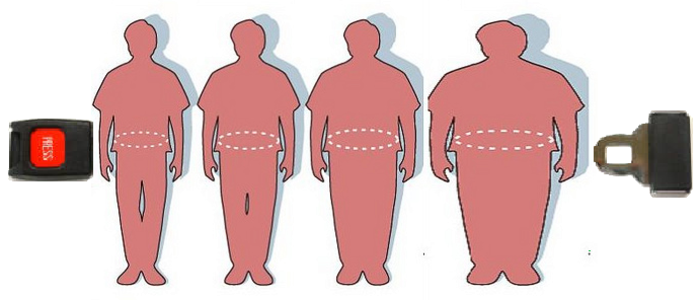Although non-alcoholic fatty liver disease (NAFLD) affects many people globally, only a small proportion of patients progress beyond the initial stages of the disease into more severe conditions, with the onset of end-stage liver disease affecting less than 13% of NAFLD patients. The progression of the condition starts with NAFLD turning into non-alcoholic steatohepatitis (NASH), which in turn turns into fibrosis and eventually cirrhosis. Following this path, after cirrhosis, patients develop hepatocellular carcinoma (HCC) and end-stage liver disease.

Credit: Photo credits: “Obesity Health Risk” by Mike Licht, NotionsCapital.com is licensed under CC BY 2.0
Although non-alcoholic fatty liver disease (NAFLD) affects many people globally, only a small proportion of patients progress beyond the initial stages of the disease into more severe conditions, with the onset of end-stage liver disease affecting less than 13% of NAFLD patients. The progression of the condition starts with NAFLD turning into non-alcoholic steatohepatitis (NASH), which in turn turns into fibrosis and eventually cirrhosis. Following this path, after cirrhosis, patients develop hepatocellular carcinoma (HCC) and end-stage liver disease.
A new Chinese Medical Journal study addresses this gap by exploring the risks, potential markers, and strategies for monitoring and treating NASH-related HCC. Dr Ming-Hua Zheng, lead researcher on the study says, “The lack of disruptive symptoms renders the early development of the disease relatively unnoticeable. And in the absence of any interference from the patient, it becomes easier for simple steatosis to progress into NASH and ultimately into HCC.”
So, what are aspects which aid this progression? Several metabolic disturbances are believed to play a vital role in the development of NAFLD.
Insulin resistance, whereby your body doesn’t respond to insulin, the hormone manages the blood sugar level, leads to the generation of excess free fatty acids (FFAs) that interfere with the normal function of the mitochondria in hepatocytes, the chief functional cells of the liver that plays a key role in the progression from NAFLD to HCC. This means that monitoring diabetes and insulin resistance is crucial in predicting cirrhosis and HCC.
The changes induced by FFAs can also trigger a condition called lipotoxicity, where elevated levels of free fatty acids interfere with the glucose metabolism pathway. Lipotoxicity can increase the production of toxic byproducts and the likelihood of tumor formation in the liver. A better understanding of the effects of lipotoxicity on NASH would provide additional options for the treatment of the condition and prevent its progression to HCC.
Oxidative stress, a phenomenon where there is an increase in the production of free radicals like reactive oxygen species (ROS), that damage tissues and cellular components due to unregulated oxidation, is another factor responsible for the progression of NASH. The excessive FFAs present in patients leads to an overproduction of ROS, which can lead to mutations in the mitochondria, increasing the risk of NASH-related HCC.
Moreover, inherited or acquired genetic characteristics of DNA repair enzymes, that differ between individuals, can also be a factor for variations of susceptibility to HCC and worsening of NAFLD.
Ageing and menopause have an impact on the development and outcome severity of the disease. Thyroid hormone levels can also influence NAFLD. The levels of these hormones can be measured to determine disease progression.
Another significant risk factor that critically affects the disease progression of NASH is unhealthy lifestyle behavior. Consumption of processed foods, unbalanced diets with high fats, and lack of regular exercise can all contribute to the development of NAFLD.
How can this disease be managed then?
Until now, there have been major guidelines for the management of NAFLD/NASH-related HCC. The treatment strategy for HCC traditionally follows the format of other diseases like the Barcelona Clinic Liver Cancer. However, HCC management has made great progress by improving its diagnostic and screening methods. This would allow establishing methods to treat the tumor in its earlier stages, thereby, increasing patient survivability.
This study paves way for future studies to better understand the development of NASH-related HCC and its exact causes. It also highlights the need for an early diagnosis of the disease to introduce necessary interventions to prevent its progression. “The continuous rise in prevalence of NAFLD patients worldwide warrants the need to coordinate appropriate healthcare measures and updating of existing guidelines for the disease,” says Dr Zheng.
***
Reference
DOI: https://doi.org/10.1097/CM9.0000000000001888
Journal
Chinese Medical Journal
DOI
10.1097/CM9.0000000000001888
Method of Research
Literature review
Subject of Research
Not applicable
Article Title
Non-alcoholic steatohepatitis and risk of hepatocellular carcinoma
Article Publication Date
20-Dec-2021
COI Statement
None



